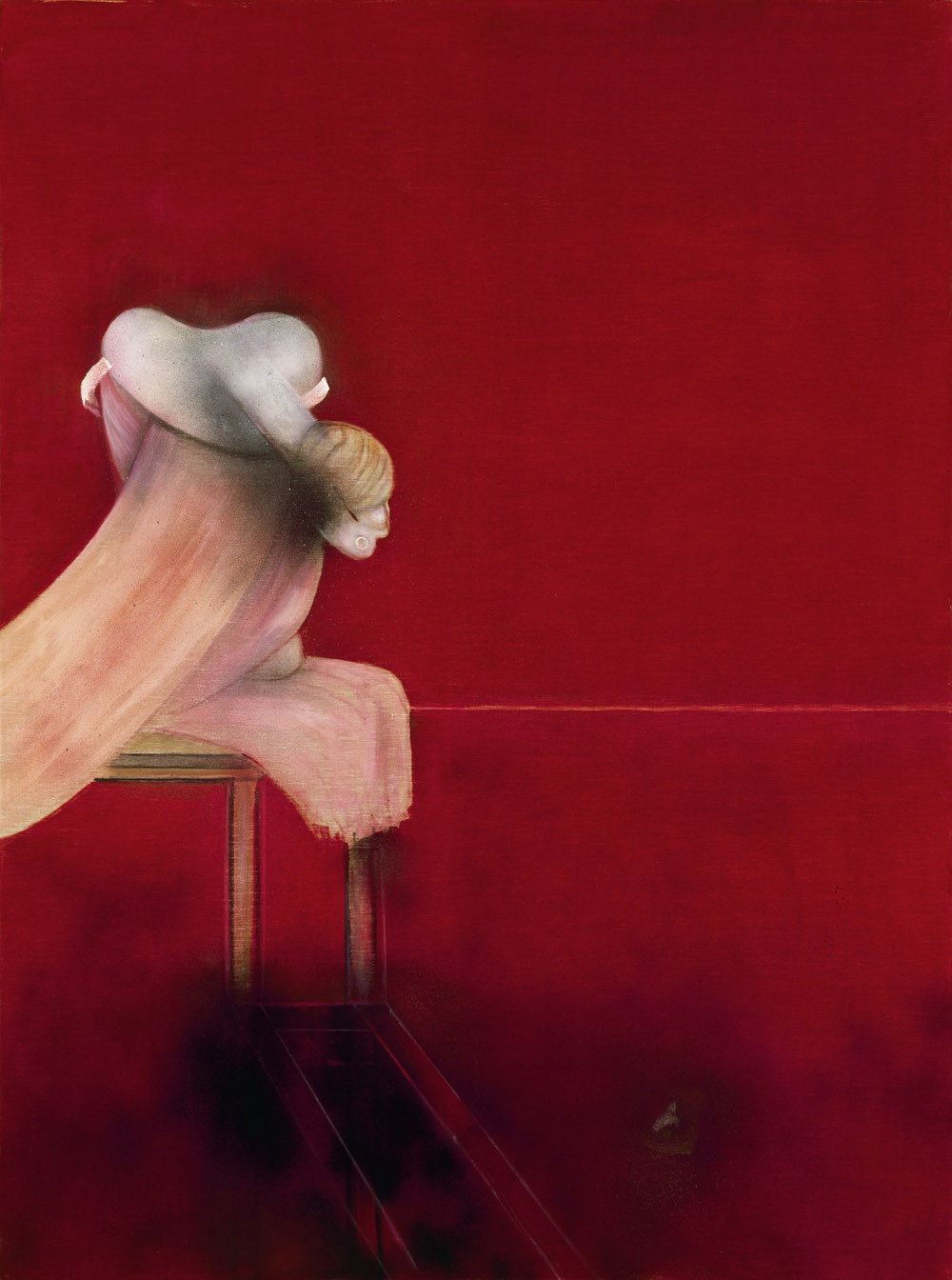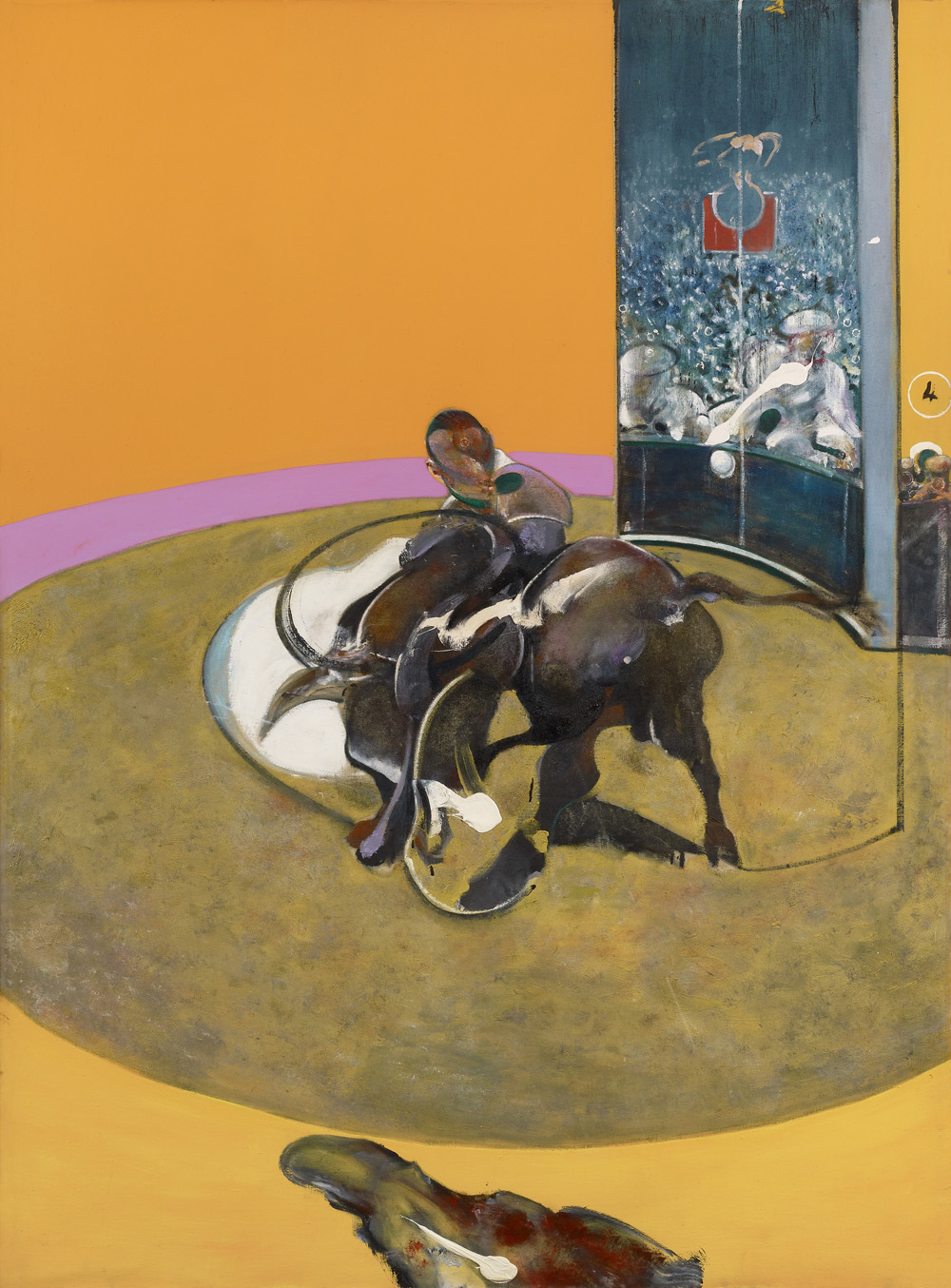Drawn to the Royal Academy for its latest major exhibition, Graham Hooper was captivated by the paintings of Francis Bacon.
IMAGE ABOVE: Francis Bacon, Second Version of Triptych 1944, 1988
Oil paint and acrylic paint on 3 canvases, 198 x 147.5 cm (each)
Tate: Presented by the artist 1991
© The Estate of Francis Bacon. All rights reserved, DACS/Artimage 2021. Photo: Prudence Cuming Associates Ltd
Green Park is as busy as I ever remember it to be, pre-Covid. There are a few people wearing masks, but it’s mostly tourists travelling to or from their London Guide destinations of the Houses of Parliament or Buckingham Palace. My old art college friend has brought along her dog, Ginger, though I’ve been warned, she loves animals and Green Park is full of them, so she’s staying on a lead. Sure enough, there are all manner of wildlife to be seen: dogs certainly, squirrels (lots of them) but horses care of the mounted police, pigeons of course (lots of them), pelicans (yes, really) but even more unexpectedly parrots, or more specifically parakeets, for the former is a sub-species of the later. My friend tells me they allegedly escaped a film set years ago and have made the London park their home ever since, brought to the city for the set of The African Queen in 1951. It’s a great story, but there are others, as further research suggests they might have arrived courtesy of Jimi Hendrix or even George Michael. People are gathering around Ginger, who is certainly very sweet and mostly well behaved, until she spots an animal to chase or snarl at if she can’t get as close as she’d like. But the crowds are also keen to be photographed alongside the other park creatures.
As I sip my coffee, I become more aware than ever of being surrounded by animals, of their behaviour, and my attitude towards them, and our relationship towards each other. It is the perfect introduction for my visit to the Royal Academy to review Francis Bacon: Man and Beast.
I am familiar with Francis Bacon’s paintings and admire his famous depictions of tortured papal figures that appear held hostage in glass cages, houses in dark rooms. The painting style (impressionistic blended brush stokes alongside hinted almost photo-realistic details of body parts, set against brightly coloured flat backgrounds) is unmistakeable. His work is as well-known as his reputation, in fact the two are inseparable. Bacon was a central figure in what is called the School of London painters, who are linked only really by their concern for the human figure at a time (the 1940’s and 50’s) when figurative painting was becoming increasingly unfashionable, as first Abstract Expressionism and then Pop-art became the dominant mode of working. Along with his friends and rivals, Bacon would frequent bars at night, drink heavily, and perhaps end up in a fight. He was also openly gay when homosexuality was still illegal. Being such a provocative and complex character has done nothing but increase the sense of aura that Bacon and his work now possess. At a time when the big London galleries are keen to draw in guaranteed audiences, after the dark days of the lockdown, a Francis Bacon show is always going to be a crowd pleaser. There have been other showings of Freud (also famed for his personality and lifestyle) and Auerbach (the more subdued of the group) in recent years, and they are rightly very popular. There is a relatively large body of paintings to choose from, and they are good paintings to see; relatively large, overtly painterly, stylistically distinctive and often almost abstract, though still very much based on the human body. What is difficult is how to re-purpose their oeuvre in a meaningful and coherent manner to make for a fresh viewing of their work, one that will bring with it new and clearer insights.

IMAGE RIGHT: Francis Bacon, Study for Bullfight No. 1, 1969
Oil on canvas, 198 x 147.5cm
Private collection
© The Estate of Francis Bacon. All rights reserved, DACS/Artimage 2021. Photo: Prudence Cuming Associates Ltd
Man and Beast is clearly an attempt to do all these things; get people back into galleries again, and to attempt a reappraisal of sorts of otherwise renowned paintings, though it must be said that the Royal Academy’s show has managed to bring together genuinely previously unseen work, and in new configurations. Using the theme of animals as a central strand is as good as any (movement or colour might have been two other equally valid and useful excuses to see these wonderful paintings though).
Cleverly, even the title alludes to Bacon himself being both a man and a beast; animalistic, feral even. But humans are animals of course, and will exhibit, for better or for worse, tendencies that we share with other creatures, tamed or otherwise, despite millions of years of evolution. It won’t escape people’s minds that very name Bacon suggests pig meat, how could it not?
Early on in the exhibition we are given biographical details that attempt to explain the painter’s fascination with animals. He was the son of a horse breeder, and growing up on a stud farm, would have been exposed to hunting, mating, death and fighting. It is used to rationalise his early fascination with the primal instincts that we see time and again in his paintings; captive figures prowling and barking.



Oil paint and acrylic paint on 3 canvases, 198 x 147.5 cm (each)
Tate: Presented by the artist 1991
© The Estate of Francis Bacon. All rights reserved, DACS/Artimage 2021. Photo: Prudence Cuming Associates Ltd
Bacon was also familiar with big game hunting, having visited his mother and sister in Africa after his father died in the early 1950’s. Then in London he would frequent the city’s zoo to observe primates and birds of prey. He noticed their movements (crouching, swinging and crawling) as much as their facial features (teeth in particular, but also more broadly their limbs). Interestingly his sever asthma was triggered by contact with dog or horse hair, so the relationship was one of attraction as much as fear.
Whilst animals do appear in Bacon’s paintings they are rarely clearly defined. What we see are mouths or an ear carefully and intricately depicted, amongst smears and swirls of oil paint. His constant use of photographs from a wide range of books and magazines is widely acknowledged, and many of these were popular wildlife magazines, though perhaps the most important ones were tomes such as Eadweard Muybridge’s published studies of human and animal motion. They are critical precursors to the invention of cinematography, being as they are sequenced and quasi-scientific recordings of animal movement. In his grids of images horses run against a dark background that provides an air of objectivity.
Perhaps as a direct result of his upbringing, that was by all accounts brutal, Bacon inherited a very matter-of-fact attitude towards animal welfare. Life appears to have been a series of dog-eat-dog survival moments, and he grew up with a love of bull-fighting for instance, which, like big game hunting, is now increasingly frowned upon for its inherent cruelty.

Oil on canvas, 91.4 x 76.2 cm
Arts Council Collection, Southbank Centre, London
© The Estate of Francis Bacon. All rights reserved, DACS/Artimage 2021. Photo: Prudence Cuming Associates Ltd
Similarly humans appear as ultimately meat, flesh and carcass, capable of extreme violence, individually or in groups. Living through world wars as much as growing up in rural Ireland at the time has taught him that. Time and again in these often-vast canvases and triptychs, distorted biomorphic figures are engaged in sexual (or is it playful?) encounters that are always dynamic and at times even frenzied. The people or animals pictured are as vulnerable as they are dangerous, and it is this repeated ambiguity that creates the feeling of power in these canvases, and they really are powerful. The intimate, sexualised brutality of all these people (his friends and lovers) painted over decades can’t help but impact on you as you walk through the exhibition. The explicit, violent eroticism is as shocking today as it would have been fifty years ago when they were first seen. No other painter, at least none that I am aware of, has really devoted such time and energy to try and understand and then portray the human body, and human relationships, in such a way. Bacon’s handling of paint, his style, is perfectly matched to his chosen subject matter too. In the best work the oil pigment dances and struggles, uninhibited but yet somehow still controlled, or sometimes splats, like blood, across the surfaces that are almost life size. All the pinks, purples and blues of bruised skin are then contrasted with orange, cream or black backgrounds.
The entire show, whilst broadly chronological, is also thematic, taking a focus such as ‘flesh, skin and bone’ as an opportunity to explore a specific facet of his interest in more detail. The Royal Academy galleries are as commanding as the paintings. They are cavernous and sensuous themselves. High ceilings and ornate doorways, coupled with the dark lighting and deep grey walls all add to the mysterious and intimate atmosphere of the works on show. It is strange to see the silhouetted groups of visitors standing still, in front of the colourful, muscular pictures of individuals or pairs. The boxes of each gallery space echo the cubes outlined in his pictures.

Francis Bacon, Portrait of George Dyer Crouching, 1966
Oil on canvas, 198 x 147 cm
Private collection
© The Estate of Francis Bacon. All rights reserved, DACS/Artimage 2021. Photo: Prudence Cuming Associates Ltd
It’s well worth the effort to really study Bacon’s technique. I took time to absorb the brushstrokes, and the colour combinations. The captions are enlightening and inconspicuous, although they are small, and sadly not printed in the gallery guide (which is a biographical chronology). If you want to read them to gain a greater appreciation or alternative understanding of the images, you’ll need to wait your turn. But there is no escaping this magnificent show. It was suitably captivating.
Francis Bacon: Man and Beast at the Royal Academy of Arts to 17 April 2022
www.royalacademy.org.uk/exhibition/francis-bacon

Francis Bacon, Study for Chimpanzee, 1957
Oil and pastel on canvas, 152.4 x 117 cm
Peggy Guggenheim Collection, Venice
Solomon R. Guggenheim Foundation, New York
Photo: David Heald (NYC)
© The Estate of Francis Bacon. All rights reserved. DACS 2021



